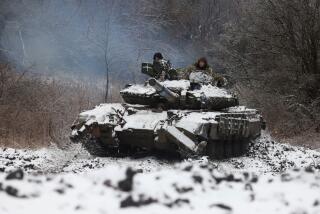Radiation trail leads to British Airways planes
LONDON â Investigators found traces of radiation on two British Airways planes Wednesday as police widened a complex international investigation into the mysterious poisoning death last week of a former Russian spy.
The discovery of polonium-210, the rare and lethal radioactive substance that killed Alexander Litvinenko and ignited a public health scare, could be a sign that police are on the trail of a suspected killer who traveled between London and Moscow. The two Boeing 767s at Heathrow Airport here, and a third plane to be tested at a Moscow airport, flew Moscow-to-London routes during the days before and after Litvinenko fell ill Nov. 1, British officials said.
Although the airline said it was alerting about 33,000 passengers who flew on 221 flights on those planes since Oct. 25, authorities said there was little health risk because they found very low levels of a substance that is dangerous only if ingested.
âWhat we have heard is that itâs either traces or very low levels,â said Pat Troop, chief executive of the government-funded Health Protection Agency. âAnd what we have learned so far in our investigation ... is that where we have got these areas of low-level radiation, it doesnât seem to pose a significant health threat.â
In a statement written shortly before his death Nov. 23, the 43-year-old dissident accused Russian President Vladimir V. Putin of ordering his assassination. But British officials say they have not ruled out other scenarios that encompass rogue Russian spies, Russian gangsters and even the possibility that Litvinenko, a former KGB agent, accidentally or deliberately poisoned himself.
The planes were targeted for investigation by Scotland Yard detectives pursuing leads developed during about 20 hours they spent questioning the hospitalized Litvinenko before he died, a British counter-terrorism official said. Detectives have scanned footage from Londonâs widespread network of security cameras and conducted numerous interviews as they reconstruct his movements and search for suspects.
âItâs widening because they are working on a timeline he gave them,â the official said. âEach CCTV image, each radioactive trace that they find needs to be followed up. As we get more information, the radiation is traveling and traveling.â
The list of flights by the three planes released by British Airways included eight between Moscow and London between Oct. 25 and Nov. 1, the day police believe Litvinenko was poisoned.
The list also cited 40 flights between Nov. 1 and Nov. 29. Investigators think some of the traces could have been left by people who had contact with Litvinenko after he was poisoned, such as two Russian businessmen who met with him at the Millennium Hotel in London on the afternoon of Nov. 1, the official said.
Traces of polonium-210 were found in the two menâs hotel rooms as well as the bar where they had tea with Litvinenko, the official said. Police think the material was transmitted from Litvinenko to the men through casual contact such as a handshake. The Russians returned to Moscow soon afterward, but they voluntarily came forward and gave statements to investigators at the British Embassy, the official said.
The two are not considered suspects and have not shown signs of contamination, officials say. So far no one, not even the victimâs family or hospital staffers who treated him, appears to have been contaminated.
âIt transfers easily, on clothing or chairs,â the official said. âBut not a single person has reported sick with the same symptoms that he had. That includes his wife and son.â
The order to test the planes went out Tuesday night, said a British Airways spokesman who asked not to be identified.
âOne of the planes was in Athens, and it was decided to bring it to Heathrow; another was already at Heathrow,â the spokesman said. âAll three flights had been to Moscow recently.â
Forensic tests revealed âvery low traces of a radioactive substance on board two of the three aircraft,â the airline said in a statement. British Airways âunderstands ... from advice it has been given that the risk to public health is low.â Though British Airways did not specifically identify the substance, two British officials confirmed that it was polonium-210.
The planes had also touched down in Barcelona, Spain; Madrid; Dusseldorf and Frankfurt, Germany; Athens; Istanbul, Turkey; Larnaca, Cyprus; Vienna and Stockholm.
In London on Wednesday, Home Secretary John Reid chaired a meeting of a multi-agency emergency committee of security and intelligence services. Reid is expected to make a statement to Parliament updating the situation today.
Litvinenko, a spy for the KGB and its successor agency who fell afoul of the Putin government, turned investigative journalist and fled Russia for political asylum in Britain with his family in 2000. Before his death, he said he was looking into the killing in Moscow last month of a fellow journalist and critic of the Putin government, Anna Politkovskaya.
On Nov. 1, he met with an Italian source, Mario Scaramella, a former secret service agent and Russia expert, to discuss the Politkovskaya case and reportedly hand Litvinenko a Kremlin hit-list on which both of their names appeared. The two met in a sushi bar in central London before Litvinenko met the Russian contacts in a central London hotel.
Police consider the sushi bar one of the likely places where a killer could have poisoned Litvinenko by slipping polonium-210 into his food, perhaps with a spray device.
Scaramella has told reporters that he is under police protection and has been cleared by tests for contamination.
Since Litvinenkoâs death, radiation searches have uncovered small traces of polonium-210 in seven locations around central London, including the sushi bar, and the two hospitals where he was treated. Traces have also been found in some central London addresses in the luxurious Mayfair area, including the home of a close friend, exiled Russian billionaire -- and Putin enemy -- Boris Berezovsky.
*
Rotella reported from Paris and Stobart from London.
More to Read
Sign up for Essential California
The most important California stories and recommendations in your inbox every morning.
You may occasionally receive promotional content from the Los Angeles Times.










